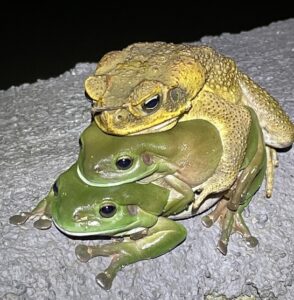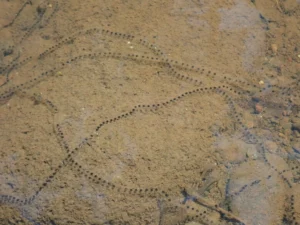Frogs and toads have many things in common. They are both amphibians in the order Anura, which means “without a tail” in Ancient Greek. They both lay their eggs in water and even look very similar. In fact, there is no scientific distinction between “frogs” and “toads.” But can frogs and toads mate and interbreed?
Frogs and toads sometimes mistakenly mate in the wild, but can not successfully interbreed, or produce viable offspring. This is because frogs and true toads belong to different families, and do not share enough similar DNA to create hybrid offspring.
For two species to successfully interbreed, the parental DNA needs to resemble each other closely enough that a hybrid offspring is possible.
In other words, the parents must share enough complementary DNA and have enough of the same sequence of base pairs – for new DNA to be formed.
This is not the case with most frog and toad species, and there are no scientifically documented cases of toad/frog hybrids.
Frogs and Toads Belong to the Same Order
Frogs and toads are both amphibians in the order Anura. Toads are essentially a sub-classification of frogs, meaning that all toads are frogs, but not all frogs are toads.
Within the order Anura, there are three suborders: Archaeobatrachia, Mesobatrachia, and Neobatrachia.
Each of these suborders has at least one superfamily consisting of two or more families. These families have genera, which contain species.
In total Anura has 29 families, over 350 genera, and over 5,000 species.
Although frogs and toads belong to the same order, they generally belong to different subfamilies and different genera.

Members of the family Ranidae, are referred to as true frogs, and those belonging to the Bufonidae family, are referred to as true toads.
For example, wood frogs (Lithobates sylvaticus), Northern leopard frogs (Lithobates pipiens), and American bullfrogs (Lithobates catesbeianus) belong to the Lithobates genus in the frog family Ranidae.
On the other hand, American toads (Anaxyrus americanus), Southern toads (Anaxyrus terrestris), and Woodhouse’s toads (Anaxyrus woodhousii) belong to the Anaxyrus genus in the family Bufonidae.
Other families of frogs and toads exist; for example, tree frogs are a different family of frogs than true frogs. However, these are smaller groupings of species, and some are specific to certain regions of the world.
Most Frog and Toad Species Are Genetically Incompatible
The vast majority of frog and toad species do not share similar DNA, and can not interbreed or reproduce in any way.
When hybrid offspring are produced, it is because the parental DNA molecules are homogeneous with each other – and are similar enough to have the same sequence of base pairs. This allows new DNA to be formed.
In other words, even though the DNA is from two different species, it is close enough in similarity to produce offspring.
This is why domestic cows can interbreed with Yaks, Zebras can interbreed with Donkeys, and Lions can interbreed with Tigers.
Very closely related toad species, or frog species, sometimes also interbreed in the wild.
For example, American toads (Anaxyrus americanus), Fowler’s toads (Anaxyrus fowleri), and Southern toads (Anaxyrus terrestris), frequently hybridize where their ranges overlap.
Gray tree frogs (Hyla versicolor) are also known to interbreed with bird-voiced tree frogs (Hyla avivoca).
A hybrid of the Cope’s gray tree frog (Hyla chrysoscelis), and the American green tree frog (Hyla cinerea) was also found. However, it did not appear to have viable spermatozoa.
On the other hand, Wood frogs (Lithobates sylvaticus) cannot interbreed with American toads (Anaxyrus americanus) because their DNA is simply not close enough in similarity to produce offspring.

For the same reason, Northern leopard frogs (Lithobates pipiens), can not interbreed with pickerel frogs (Lithobates palustris), despite their visual similarities.
All Frog and Toad Species Have a Unique Mating Call
During the mating season, male frogs call for females – usually from ponds, swamps, streams, and other possible breeding sites.
Each frog species has a different call and female frogs will only be attracted to the call of their own species.
For instance, female spring peepers frogs will only be attracted to the calls of male spring peepers, and female American toads will only be attracted to the calls of male American toads.
When females are ready to mate, they will move towards calling males, and pick the male that they prefer.
In some frog species such as the barking tree frog, most females will mate with the male closest to them. This is especially more likely when the distance to other calling males is large.
However, in many species, females can be much more selective. Some species prefer males who make their calls longer and more frequent – and other species prefer males who call next to a pre-made nest.
The Females of Some Frog Species Can “Filter Out” the Calls of Males From Other Species
It’s common for males of so many different frog species to call from the same pond, trying to attract potential mates. Homing in on the right males can be a challenge for female frogs.
However, research has shown that the females of some frog species such as the American green tree frog (Hyla cinerea), can make their eardrums less sensitive to the croaks of other species. They do this by simply inflating their lungs.

The extra vibrations of the lungs cancel out sounds of the same frequency at the eardrum, reducing sensitivity.
This decrease in sensitivity falls just between the two most prominent frequencies of a male green tree frog’s croak, so it does not affect the female’s ability to hear her own species.
Sometimes, Toads Try to Mate With Frogs & Vice Versa
Many toad and frog species often share breeding ponds, and misdirected amplexus may occur.
Male toads may mistakenly grab onto frogs, and attempt to mate with them – this is known as “misdirected courtship”.
The misdirection is caused by a mistake during species recognition.
In other words, the toad mistakes the frog for a female toad, and attempts to mate with it.

Occasionally, a male toad will clasp another male and attempt amplexus.
When this happens, the male being mounted will produce a vibration in the area of his chest where he is being clasped and emit a squeak (known as a release call) and the offending male will immediately let go.
Male toads have also been observed attempting to mate with incompatible species, dead female toads, and even with objects or non-amphibian species.
When a female frog is clasped by a male toad, it may react by not releasing eggs, or releasing an amount just enough to get the toad off its back.
If the male toad attempts to fertilize the eggs released by the frog, it is unlikely that the eggs will be fertile. They will most likely not hatch due to differences in the genetic makeup of the ‘parents.’
Frogs and Toads Lay Their Eggs Differently
Not only are frogs and toads genetically incompatible, but they also generally lay their eggs differently.
Most frogs lay their eggs in large clusters. The eggs look like jelly-like globs, with a developing embryo visible inside each egg. The embryos can appear as black, brown, or even cream-ish yellow dots inside each egg.

On the other hand, most toads lay their eggs in long jelly-covered strings, which may look like a string of black beads. Sometimes sediment settles on the egg strings, covering individual eggs and making them look like giant worms.

When first laid, both frog and toad egg masses are very dense and tightly packed together. Over time, the jelly surrounding the eggs absorbs water until each egg is covered with a thick jelly coating.
This jelly enables the eggs to float near the surface of the water, where it is warmer and there is more oxygen.
The jelly also holds the eggs together and protects the developing embryos from the elements by virtue of its sticky texture and its tendency to accumulate a covering of pond debris.
In addition, it acts as a “shock absorber” to prevent injury to the egg from the water movement.
Here is a side-by-side comparison of frog eggs and toads eggs:

Common Questions About Frog Reproduction
Can Frogs of Different Species Mate and Interbreed? Different frog species can mate and successfully interbreed if they are genetically related very closely – to the point where the parental DNA resembles each other closely enough that a hybrid offspring is possible.
Conclusion
Toads and frogs sometimes attempt to mate in the wild, but this is usually due to a mistake in species recognition.
When mating does occur, they do not successfully hybridize, because their DNA is not close enough in similarity to produce offspring.
Frog eggs fertilized by a male toad will most likely not be fertile, and won’t hatch – due to differences in the genetic makeup of the ‘parents.’
However, hybridization among closely related frog species or toad species sometimes occurs in the wild.
Gray tree frogs occasionally inbreed with bird-voiced tree frogs, and American toads interbreed with Fowler’s, and Southern toads.
Still, interbreeding between toads and frogs has never been observed, or proven scientifically possible.
Photo credit: Simon Pardoe (CC BY-NC-ND 2.0)
Sources:
Ledford, Heidi. (2007). Toads mate across the species divide. Nature. 10.1038/news.2007.231.
Mecham, J. S. (1960). NATURAL HYBRIDIZATION BETWEEN THE TREE FROGS HYLA VERSICOLOR AND HYLA AVIVOCA. Journal of the Elisha Mitchell Scientific Society, 76(1), 64–67. http://www.jstor.org/stable/2433442
Matthew J. Parris, HYBRIDIZATION IN LEOPARD FROGS (RANA PIPIENS COMPLEX): LARVAL FITNESS COMPONENTS IN SINGLE‐GENOTYPE POPULATIONS AND MIXTURES, Evolution, Volume 53, Issue 6, 1 October 1999, Pages 1872–1883, https://doi.org/10.1111/j.1558-5646.1999.tb04569.x
Dufresnes, C., Litvinchuk, S. N., Rodrigues, N., Perrin, N., Crochet, A., & Jeffries, D. L. (2020). Hybridization and introgression between toads with different sex chromosome systems. Evolution Letters, 4(5), 444-456. https://doi.org/10.1002/evl3.191
Pyburn, W. F., & Kennedy, J. P. (1960). Artificial Hybridization of the Gray Treefrog, Hyla versicolor (Hylidae). The American Midland Naturalist, 64(1), 216–223. https://doi.org/10.2307/2422903
Hettyey, Attila & Baksay, Sandra & Vagi, Balazs & Hoi, Herbert. (2009). Counterstrategies by female frogs to sexual coercion by heterospecifics. Animal Behaviour. 78. 1365-1372. 10.1016/j.anbehav.2009.09.006.
BARBARA K. MABLE AND JAMES P. BOGART. CALL ANALYSIS OF TRIPLOID HYBRIDS RESULTING FROM DIPLOID-TETRAPLOID SPECIES CROSSES OF HYLID TREE FROGS. Bioacoustics. The International Journal of Animal Sound and its Recordings, 1991, Vol. 3, pp. 111-1190952-4622/91


